Social Media SEO: How To Use Social Media To Boost SEO

Social media and SEO might seem like two separate — and sometimes, untamable beasts — but they’re more connected than you might think.
Today, social media platforms have their own special way of ranking and displaying content. When you know how to march to the beat of their drums, you’ll enjoy more relevance and engagement on social media.
And that feeds into traditional SEO.
The more you amplify your small business on the most popular social platforms, the more likely search engines like Google are to pick up your content, understand who it’s for, and serve it to those folks on their front pages.
This matters because 63% of all web traffic in the U.S. starts with Google.
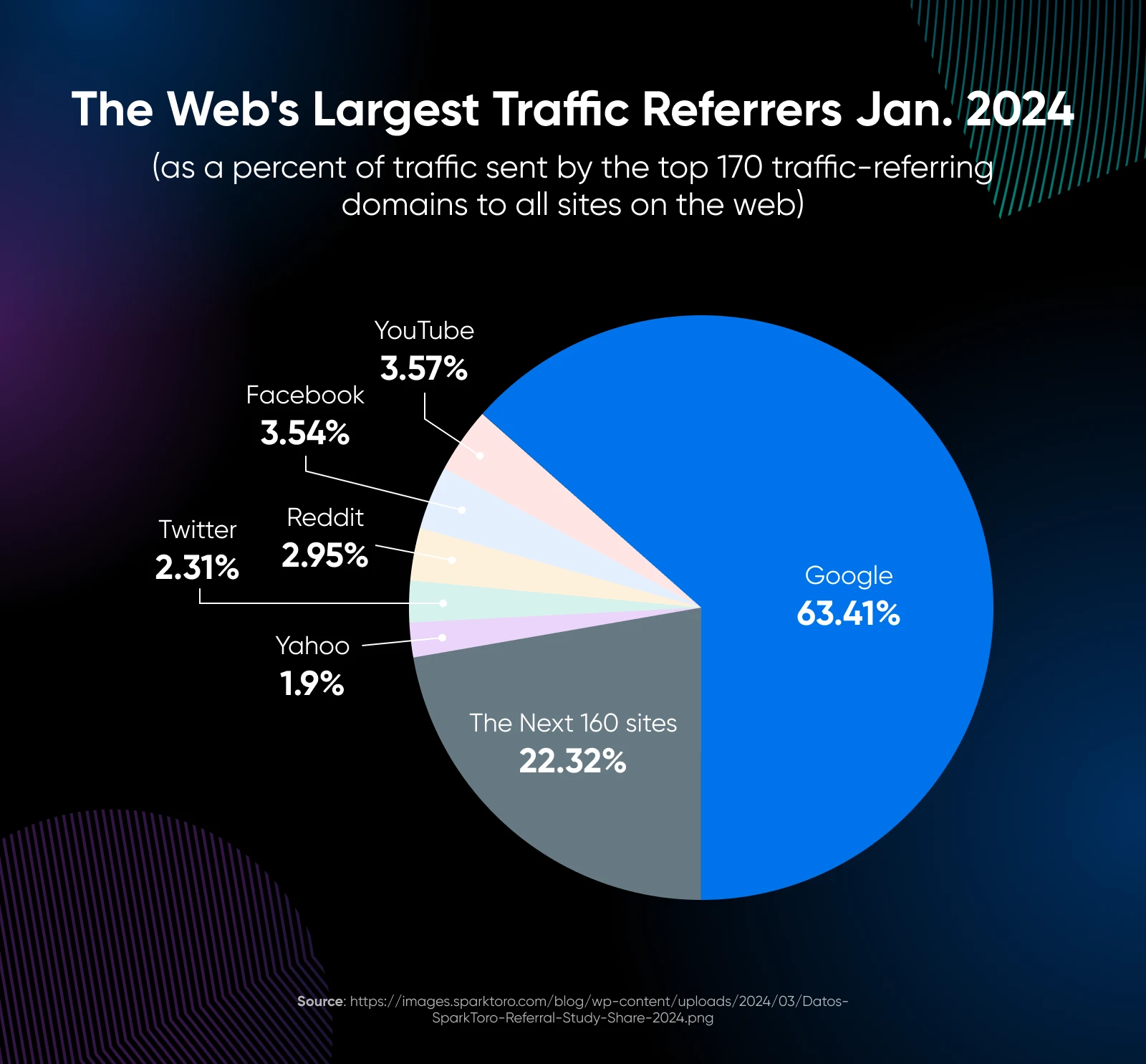
So if your goal is to gain an edge in the high-competition world of running a small business and move up the rungs in your Google ranking —which should be at least one of your goals! —one slightly more approachable way to do so may be through boosting social media SEO.
Today, we’ll guide you through doing just that, platform by platform.
Social media SEO amounts to applying some of the typical search engine optimization (SEO) techniques to your social media posts and profile, so they appear when people use those platforms to look for content related to yours.
To grasp social SEO, knowing the basics of traditional SEO is immensely helpful.
In digital marketing, optimizing your website for search engines is what helps Google, Bing, etc. understand your content and deliver relevant results based on users’ search terms, location, and browsing history.
While social platforms are not traditional search engines, today, most of them have social search features — and they’re increasingly adopting search engine-like functionality to help their users locate specific content. Increasingly, people actively use these platforms to search for things like reviews, recommendations, and local businesses.
For example, say someone’s planning a trip to Japan for the first time, so they hit up Instagram and TikTok to search for amazing sushi recommendations. The algorithms on these social sites are likely to show them profiles and posts that use language that focuses on travel, food, and Japan in particular.
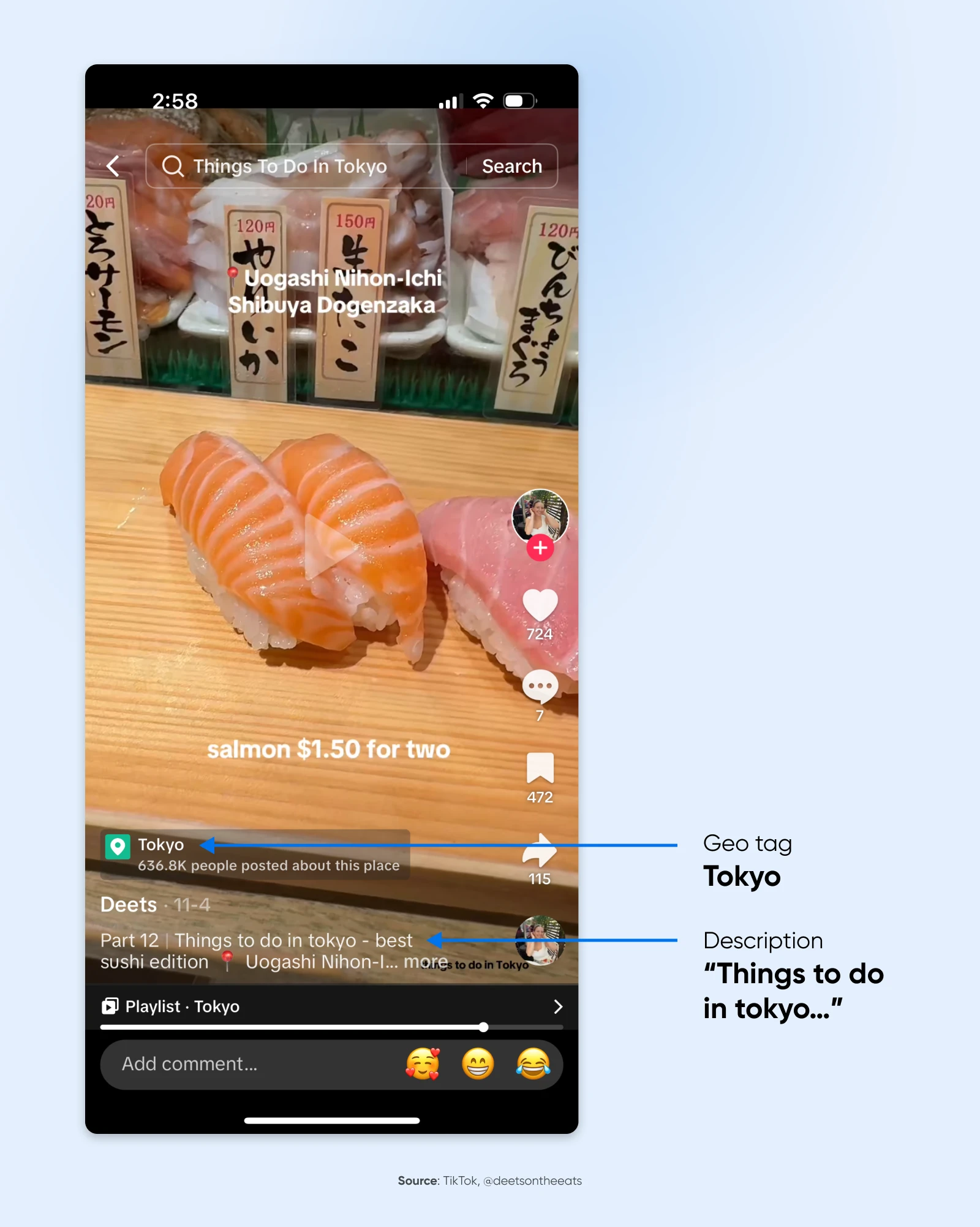
Here’s what’s interesting — Google currently denies using social media profiles and performance when ranking content for its search engine results pages. However, it wasn’t always this way.
There was a time when they said they actively did consider social presence a key part of SEO. Google likes to keep the “secret sauce” behind its ranking algorithm somewhat close to the chest, so it’s easy to assume this practice never fully went away, despite their denial.
Speaking of, it’s no surprise that some research has found a correlation between social success and better Google rankings.
And then there’s Bing, which has a lower traffic volume than Google but still sees 100 million users daily! Bing doesn’t obfuscate, they’re very clear that they look at social media performance when deciding how to rank content.
We think it’s reasonable to assume how your profile and social media content are optimized, and perform, probably affects your SEO.
Ready to help your social media profile and content appear in front of ready-to-buy audiences?
In this section, we’ll give you hyper-specific social media strategies you can start implementing today to improve performance and make all your social media marketing worth it.
Beef Up Your LinkedIn SEO
- Figure out the best keywords: You’ll see a similar thread throughout this section — for each platform, you’re pretty much always going to start with keyword research. However, discovering which keywords to focus on will vary a bit. With LinkedIn, you’ll want to do a little manual research to see what phrases popular people and posts in your industry are using. Check out the top stories of the day, and start typing in the search bar to see what comes up — these are things people have been looking for. A good secondary option is always to use Keyword Planner from Google Ads to check the popularity of phrases you’ve already thought of and generate new ones based on those.
- Optimize your profile: If you pay attention, you’ll notice a lot of regular LinkedIn users update their profiles quite often. You can do the same by refreshing from time to time to include relevant keywords in your “Headline” and “About” sections to improve your SEO.
- Create keyword-focused content: On LinkedIn, you can write both: posts and articles. Think of posts as short-term content for capitalizing on trends and articles as more traditional, long-form, SEO-focused outlets. You’ll want to tap into your keyword research here!
- Avoid keyword stuffing: Be careful — LinkedIn quickly flags content as spam if it’s overloaded with keywords or hashtags. Use keywords naturally and limit hashtags to those that are genuinely relevant.
Get Discovered With YouTube SEO
- Research keywords first: Keyword Planner is a brilliant resource, and YouTube’s trending page and the auto-complete feature in its search bar are also great ways to see what your audience is seeking. Also, a quick Google search will uncover many apps explicitly built to find the best phrases to target on YouTube. This list can help you find some options.
- Name your video file wisely: Use your primary keyword in the name of the video file you’re uploading to YouTube. For example, “web hosting 2024.mov”.
- Optimize titles and descriptions: Again, include your primary keyword in your video title, as well as in the first few lines of your description (so it’s visible without expanding).
- Include keywords in your script: Be sure you’re actually saying your top keywords during your videos. Additionally, remember to enable captions and subtitles for another chance to get your target phrases associated with your videos.
How To Boost Instagram SEO
- Optimize target keywords: You guessed it, the first step is to hone in on the best target phrases from your Instagram page! Find your branded and industry-focused keywords via Google or similar research tools. Then, head to Instagram and start typing in the search bar to see how people search for content related to your business.
- Implement keywords: Now, get to work using those keywords wherever you can. In your name (if applicable — don’t go switching it up every month!), bio, captions, etc.
- Add alt text: Alternative text is used on graphics across the internet to improve accessibility. It’s also used by search engines to ensure they understand the context of an image. Here’s how to add alt text to your Instagram posts to increase visibility.
- Turn on captions: There are a few ways to use captions in your Instagram video-based posts. Here’s how to turn them on, again for accessibility as well as visibility of your target phrases for Instagram and external search engines.
- Use locations: If you’re a local business, tag your location to help your posts appear when folks search for something near them.
Learn more: How To Get More Likes on Your Instagram Posts (12 Social Pro Tips)
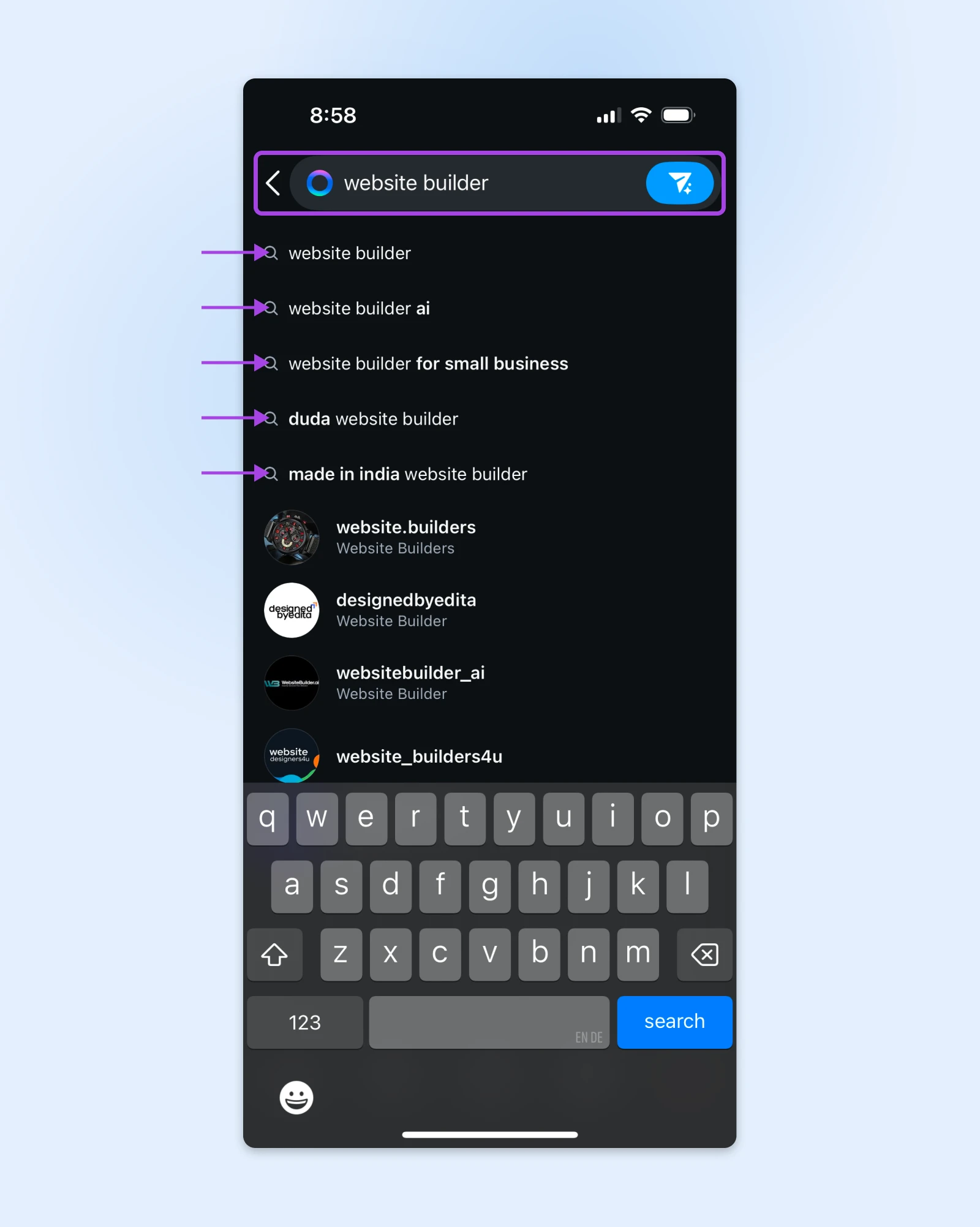
Facebook SEO Strategies for Success
- Suss out keywords: The usual suspects will help you figure out what topics to focus on with your Facebook content. Facebook also has an Insights section where you can learn more about your audience and which of your posts perform the best — from which you can infer phrases to target.
- Use ‘em: Add your primary keywords wherever you can on your business Facebook page — username, the “About” section, and of course posts, photo captions, etc.
- Get local: Adding your address helps your page appear in local search results. For multiple physical locations, set up individual location pages to improve their visibility for nearby consumers.
- Use alt text: Usually, Facebook is a pretty visual platform. So, when you use graphics, be sure to attach optimized alt text (here’s how).
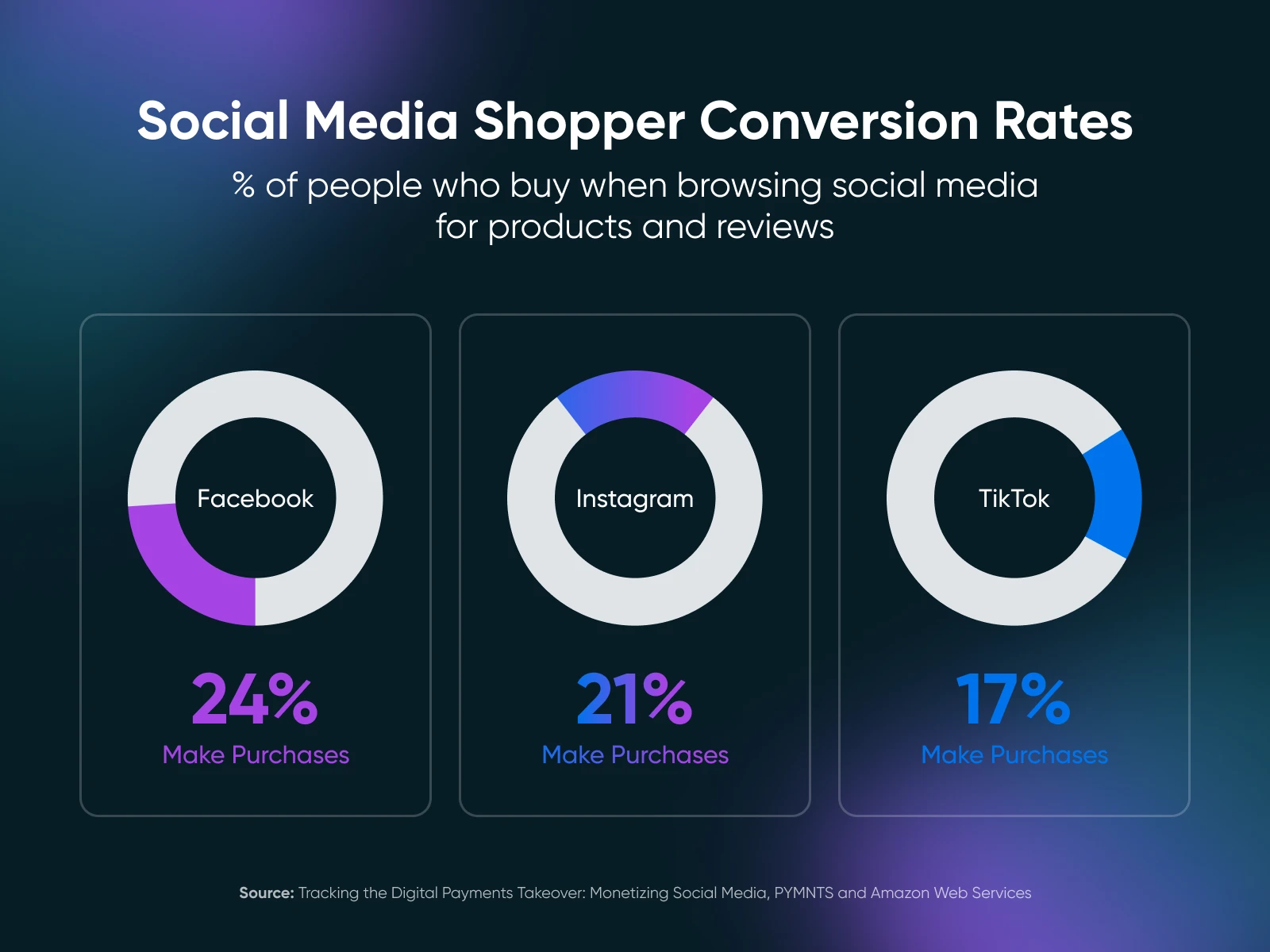
X (FKA Twitter) SEO Tips
- Keyword discovery: X seems to be doing away with the trending topics area, but there is currently an “Explore” tab filled with recent news. And hashtags are still going strong. Aside from traditional keyword research, these elements help you figure out what types of phrases your audience engages with at any time.
- Use keywords wisely: With limited characters — though the limits are much higher now than they used to be — incorporate keywords naturally into posts and your bio section so your content for social is optimized, but still valuable to readers.
- Be consistently relevant: Focus on posting regularly about popular topics and/or topics related to your brand. The more you do this, the more you’ll be grouped in with top minds in your space, making your tweets more likely to appear to interested audiences.
- Deploy that alt text: Another way to maximize all your research and SEO? The platform has made it easy to include keywords (no stuffing, please!) when adding alt text.
Take TikTok SEO by Storm
- Identify longer target phrases: There’s a lot of competition on TikTok. One way to stand out may be to focus on long-tail keywords. Do this by first using Google to find your best keywords, then typing them into TikTok’s search to find more robust phrases to target. For example, “web hosting” may get you lost in the mix — but “web hosting recommendations for small business” may get you in front of the ideal scrollers.
- Upgrade your information: You know what’s next — get those keywords into your TikTok bio! Pair this up with links to your best content (more on that in the next section) to make your TikTok bio more actionable.
- Maximize videos: There are a lot of factors about TikTok posts that are considered when they’re ranked for display: the actual content, text used in the content, captions, titles, descriptions, hashtags, and the sound you choose. Think about how you can use keywords in all of these for a major SEO boost.
While the above platform-specific tips are helpful, we don’t want to get too laser-focused and lose sight of the expansive land of SEO opportunities.
So, let’s take it a little further with these five actionable but more broad SEO best practices to help you take your social media SEO to the next level.
Link Me Up, Scotty
There’s a lot to think about when it comes to linking your website content to your social media.
Links shared via social media posts are typically no-follow links, meaning they don’t impact SEO on the linked site. However, that does not make them useless.
First of all, they can still drive traffic and attract potential customers. Second, sharing no-follow links in a roundabout way can actually signal to search engines that you’re sharing real, high-value content — not just doing it for advertising or to get SEO points from them.
As for using URLs in your social media bios, those are follow links. So, they’re valuable both for boosting SEO and directing your audience to your site.
All that said, the gist of this tip is to share links to your quality website content wherever reasonable. Learn the ropes of each platform and figure out when it makes the most sense to drop a link in.
One type of link may be a great fit for your bio, a shortened landing page link may hit big in a TikTok caption, and directing readers back to a blog link will probably make a lot of sense in a LinkedIn post summarizing your latest guide.
Upgrade Content Creator Bios
Search engines are increasingly valuing the people who create the content on your website. We were excited to discover this!
They aren’t just looking at the content on the page anymore, they’re looking at your authors and gathering information about them from their social media presence!
So, by really focusing on fleshing out those short little bylines or bios you add to the beginning or end of your blog posts, you’ll be able to enhance SEO performance.
Here’s how to get started:
- Include social media links: First and foremost, you want to link to each creator’s social media profiles within their bio. This allows search engines to verify the author’s online presence and authority in their niche.
- Highlight expertise: Use the space you have to quickly describe the creator’s qualifications, experience, or achievements related to the content they produce. This builds trust with readers and boosts credibility with search engines.
- Tag creators in new content: On social media, tag authors whenever their work is published to reinforce their association with your brand.
- Maintain consistency: Where you can, make sure creator bios look consistent across every platform to make it easy for readers and search engines to identify that it’s the same person.

Optimize Your Social Profiles
We’re going to practice some linking as well as bio optimization in this one, which combines the previous two pieces of advice — kind of.
Think of your profile on every social media site as your shop’s storefront. It must speak to search engines, grab visitor attention, and have the tools to enable them to convert should they so choose.
How the heck are we going to do that?!
It’s actually not so mystifying when you take these steps:
- Craft a keyword-rich bio: Here’s another reminder to include niche-specific keywords that your audience is searching naturally in your description to improve search visibility.
- Focus on your username: You want to use the same professional name — branded or as close as you can get to your real one — for all your social media pages.
- Add location, links, and a CTA: Include your location (if relevant) to boost local SEO website or landing page links where visitors can convert (sign up, make a purchase, etc.), and clear calls-to-action that tell them why they should bother clicking.
- Showcase top content: Pin your best-performing and most informative posts to instantly engage new visitors.
- Ensure consistency: Try as much as you can to use the same username, profile picture, general description, and branding (logo, colors, tone) across all your social profiles. For example, social media influencer @drjuliansaas uses the same photo and username for TikTok and Instagram.
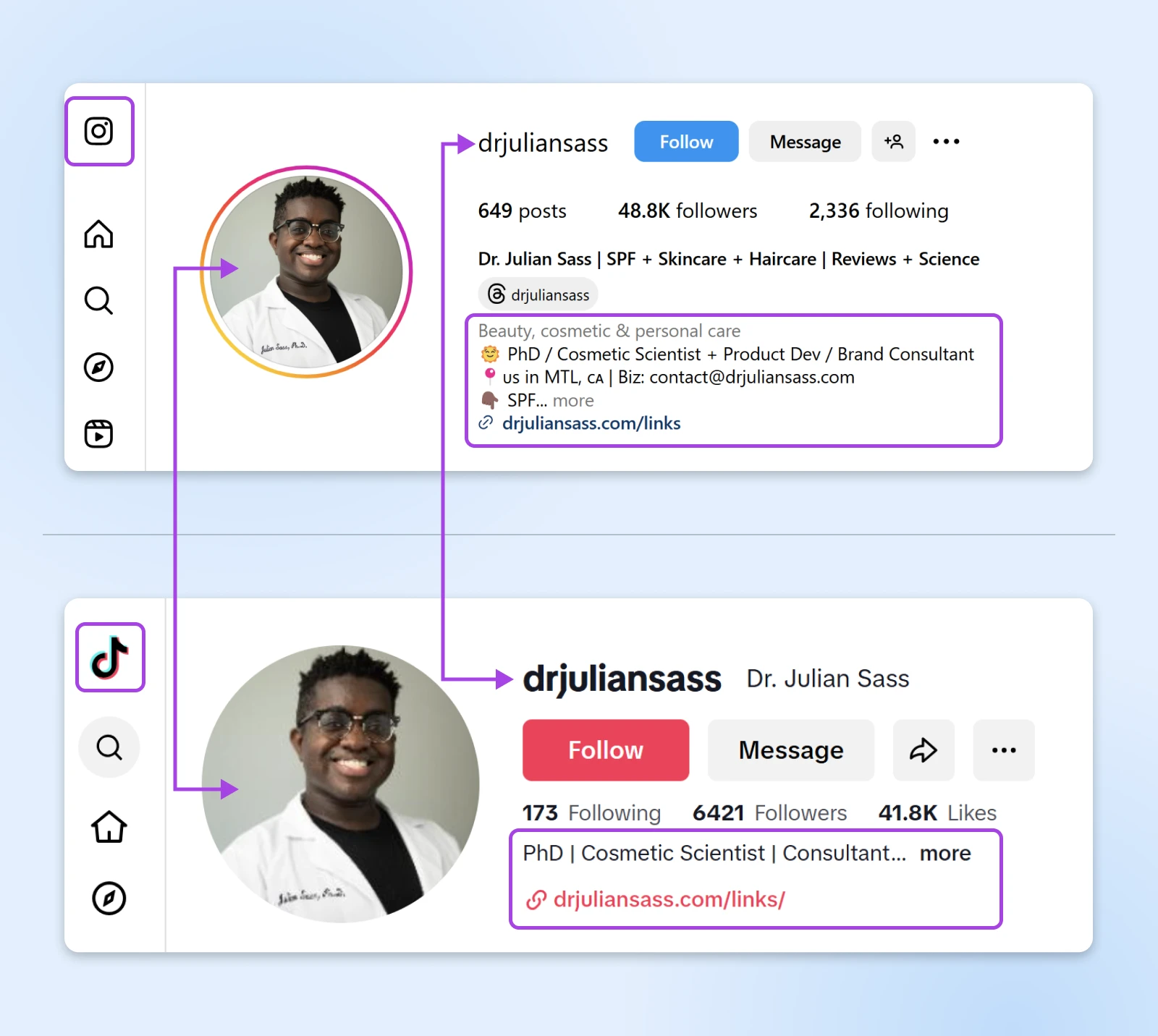
Chime In on Trending Topics
Social content often has a shorter lifespan compared to traditional content. Find a way to join the latest conversations on social media in order to keep your content fresh and relevant for both readers and search engines.
On places like LinkedIn, this may be all about using trending hashtags. On platforms like TikTok and Instagram, the best way to do this is by using trending audio clips. Many of these come with associated formats, so as long as you can adapt your content to fit the trend and it doesn’t completely go against your brand’s “vibe” —get creating and see what you can do!
This may feel silly at first, but here’s why it matters: engaging with trends is a powerful way to boost your content’s visibility.
Social media algorithms pretty much always prioritize trending content, increasing engagement, and positioning your posts at the top of relevant keyword searches.
And given that social engagement and better SEO performance across the board seem to be correlated in many cases, you want to position yourself to take advantage of this synergy.
Build a Good Online Reputation Through Listening
One last thing: A strong social media presence isn’t just about spraying out tons of content every day. It also requires fostering positive relationships with your audience.
Aside from supplying them with great content, another way to build a great reputation is through social listening and responding to what people have to say about your content, brand, and industry.
Social media listening tools are a great way to keep your ears to the ground. These platforms (think Sprout Social, Hootsuite, etc.) let you set up notifications for when people on different social platforms post about something you’re interested in. That could be your brand name, a current event that’s unfolding, a key industry term, your founder, and so on.
Often, they’ll even tell you the sentiment behind the mention and let you reply right there in your dashboard!
A strategy like this can help you optimize your social media strategy based on real feedback to make it more relevant, engaging, and visible for both followers and search engines.
Truly, the rise of algorithm-driven content and social shopping trends has transformed how both consumers and search engines find, prioritize, and interact with brands and their content.
Let’s explore how a well-crafted social media SEO strategy will soon be critical for building the relationships, sales, and future you want for your small business.
Extend Your Reach
With over 5 billion people using social media (seriously), you’ve got a lot of chances of getting in front of a lot of eyeballs by delivering high-quality, engaging content that caters to your audience.
Thanks to the algorithmic and viral nature of social platforms, this is the core of success with social media SEO: the better optimized your content is, the wider your reach.
Greater reach leads to more engagement and spawns even more growth — helping your brand reach more and more consumers steadily over time.
It’s Where People Want To Shop
In 2024, over 40% of consumers reported they’d rather find brands they were researching on social media, and not on a traditional search engine.
Add to that, a huge majority (more than 80%) would prefer to actually do their purchasing via social media — versus buying directly from a business’s website or even a marketplace like Amazon!
Suffice to say, social is where modern consumers are doing their shopping. If your profiles aren’t optimized to appeal to and deliver to those folks, you’re going to miss out on a huge part of your market.

Grow Consumer Trust by Connecting Your Brand + Your Social
While social media offers convenience for shoppers, sellers, of course, still face challenges in making conversions. The chief issue among them? Winning over consumer trust.
37% of consumers worry about sharing their personal data safely with brands they only know from social media, and a close 31% end up being skeptical about whether a business they found on social is legit. Nearly 30% worry about the quality of products purchased from social brands.
When you have a whole SEO strategy built around creating a knowledgeable, trustworthy brand that carries over to your social media presence, you can provide transparency and a reliable customer experience.
Drive an Engaged Audience Into Your Sales Funnel
Bite-sized, visually appealing, keyword-rich content is critical for keeping your social media followers hooked. As such, it encourages them to interact, share, and follow your brand.
This continuous engagement builds a steady flow of potential customers entering your sales funnel, where you can nurture them with targeted messaging and guide them toward conversion.
It’s a win-win for strengthening your online presence while boosting your money-making opportunities.
Remember: The Best Social SEO Can’t Outrun a Bad Website
A consistent social media presence can do a lot to boost your SEO and build meaningful connections with your audience.
The strategies outlined in this guide should allow you to build an effective social SEO strategy that drives real results.
But, at the end of the day, what’s the point of driving people to the ultimate endpoint —your website or an actionable landing page —if it’s not optimized for conversion?
Your site must be fast, user-friendly, and ready to handle any amount of traffic your SEO efforts bring in.
Don’t even have a website online just yet? You’re gonna love our AI-powered Liftoff Website Builder.
Got a great site, but don’t have the time or tools to keep it up to date for modern consumers? Our pro web design and website management services are standing by to take it off your hands.
Or is the need for speed what’s really holding you back? You may need a website hosting upgrade — and boy, do we have an option for everyone!
You can’t keep running from a bad online experience, but you can outpace competitors with these social media SEO strategies and partnering with DreamHost to upgrade your website.

Pro Services – Social Media Marketing
Get Social and Grow Your Business with DreamHost
Our experts will help create a powerful social media strategy and level up your execution so you can focus on running your business.
Learn More


